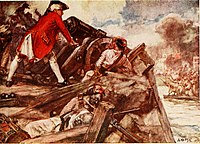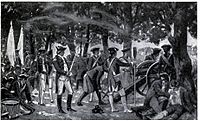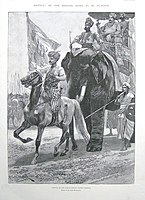Carnatic wars: Difference between revisions
Tags: Mobile edit Mobile app edit Android app edit |
Tags: Mobile edit Mobile app edit Android app edit |
||
| Line 74: | Line 74: | ||
File:Lally at Pondicherry by Paul Philipotteaux.jpg|Lally at [[Pondicherry]]. |
File:Lally at Pondicherry by Paul Philipotteaux.jpg|Lally at [[Pondicherry]]. |
||
File:Shah-alam-ii-mughal-emperor-of-india-reviewing-the-east-india-companys-troops-1781-1894 1247854.jpg|Jean Law's Memoire: ''Mémoires sur quelques affaires de l'Empire Mogol 1756–1761'' contains detailed information about the campaign of the [[Mughal Emperor]] [[Shah Alam II]] and his [[France|French]] allies against the [[British East India Company]].<ref>{{cite web|url=https://www.youtube.com/watch?v=YRK1x3GSmYk|title=Niall Ferguson - Empire: How Britain Made the Modern World - Why Britain? 4/5|work=YouTube|accessdate=28 September 2014}}</ref> |
File:Shah-alam-ii-mughal-emperor-of-india-reviewing-the-east-india-companys-troops-1781-1894 1247854.jpg|Jean Law's Memoire: ''Mémoires sur quelques affaires de l'Empire Mogol 1756–1761'' contains detailed information about the campaign of the [[Mughal Emperor]] [[Shah Alam II]] and his [[France|French]] allies against the [[British East India Company]].<ref>{{cite web|url=https://www.youtube.com/watch?v=YRK1x3GSmYk|title=Niall Ferguson - Empire: How Britain Made the Modern World - Why Britain? 4/5|work=YouTube|accessdate=28 September 2014}}</ref> |
||
File:The battle of Plassey, June 23, 1757.jpg|English guns at The battle of [[Plassey]], June 23, 1757. |
|||
File:The Navab's arrival before Clive's position.jpg|[[Nawab of Bengal]], [[Mir Qasim]] at the [[Battle of Buxar]] |
File:The Navab's arrival before Clive's position.jpg|[[Nawab of Bengal]], [[Mir Qasim]] at the [[Battle of Buxar]] |
||
File:Hutchinsonsstory00londuoft 0234.jpg|The [[Black Hole of Calcutta]], 20 June [[1756]]. |
File:Hutchinsonsstory00londuoft 0234.jpg|The [[Black Hole of Calcutta]], 20 June [[1756]]. |
||
Revision as of 16:24, 4 December 2018
| Karnatic Wars | ||||||||
|---|---|---|---|---|---|---|---|---|
 Lord Robert Clive meeting with Mir Jafar after the Battle of Plassey, oil on canvas (Francis Hayman, c. 1762) | ||||||||
| ||||||||
| Belligerents | ||||||||
| Commanders and leaders | ||||||||
|
Alamgir II Anwaruddin † Nasir Jung † Muzaffar Jung † Chanda Sahib † Raza Sahib Wala-Jah Murtaza Ali Abdul Wahab Hyder Ali Dalwai Nanjaraja Salabat Jung |
Dupleix De Bussy Comte de Lally d'Auteil (POW) Law (POW) De la Touche |
Robert Clive Stringer Lawrence | ||||||
The Carnatic Wars (also spelled Karnatic Wars) were a series of military conflicts in the middle of the 18th century in India. The conflicts involved numerous nominally independent rulers and their vassals, struggles for succession and territory, and included a diplomatic and military struggle between the French East India Company and the British East India Company. They were mainly fought on the territories in India which were dominated by the Nizam of Hyderabad up to the Godavari delta. As a result of these military contests, the British East India Company established its dominance among the European trading companies within India. The French company was pushed to a corner and was confined primarily to Pondichéry. The East India Company's dominance eventually led to control by the British Company over most of India and eventually to the establishment of the British Raj.
In the 18th century, the coastal Carnatic region was a dependency of Hyderabad. Three Carnatic Wars were fought between 1746 and 1763.
Background

The Mughal Emperor Aurangzeb died in 1707. He was succeeded by Bahadur Shah I, but there was a general decline in central control over the empire during the tenure of Jahandar Shah and later emperors. Nizam-ul-Mulk established Hyderabad as an independent kingdom. A power struggle ensued after his death between his son, Nasir Jung, and his grandson, Muzaffar Jung, which was the opportunity France and England needed to interfere in Indian politics. France aided Muzaffar Jung while England aided Nasir Jung. Several erstwhile Mughal territories were autonomous such as the Carnatic, ruled by Nawab Dost Ali Khan, despite being under the legal purview of the Nizam of Hyderabad. French and English interference included those of the affairs of the Nawab. Dost Ali's death sparked a power struggle between his son-in-law Chanda Sahib, supported by the French, and Muhammad Ali, supported by the English.[2]
One major instigator of the Carnatic Wars was the Frenchman Joseph François Dupleix, who arrived in India in 1715, rising to become the French East India Company's governor in 1742. Dupleix sought to expand French influence in India, which was limited to a few trading outposts, the chief one being Pondicherry on the Coromandel Coast. Immediately upon his arrival in India, he organized Indian recruits under French officers for the first time, and engaged in intrigues with local rulers to expand French influence. However, he was met by the equally challenging and determined young officer from the British Army, Robert Clive.
"The Austrian War of Succession in 1740 and later the war in 1756 automatically led to a conflict in India...and British reverses during the American War of Independence (1775-1783) in the 1770s had an impact on events in India."[2]
At that time it was the policy of the Peshwa and the local Maharajas to fight the Europeans; while many subjects of the Great Mogul however continued to support European presence in the Indian subcontinent.
First Carnatic War (1746–1748)

In 1740 the War of the Austrian Succession broke out in Europe. Great Britain was drawn into the war in 1744, opposed to France and its allies. The trading companies of both countries maintained cordial relations in India while their parent countries were bitter enemies on the European continent. Dodwell writes, "Such were the friendly relations between the English and the French that the French sent their goods and merchandise from Pondicherry to Madras for safe custody."[3] Although French company officials were ordered to avoid conflict, British officials were not, and were furthermore notified that a Royal Navy fleet was en route. After the British initially captured a few French merchant ships, the French called for backup from as far afield as Isle de France (now Mauritius), beginning an escalation in naval forces in the area. In July 1746 French commander La Bourdonnais and British Admiral Edward Peyton fought an indecisive action off Negapatam, after which the British fleet withdrew to Bengal. On 21 September 1746, the French captured the British outpost at Madras. La Bourdonnais had promised to return Madras to the English, but Dupleix withdrew that promise, and one to give Madras to Anwar-ud-din after the capture. The Nawab then sent a 10,000-man army to take Madras from the French but was decisively repulsed by a small French force in the Battle of Adyar. The French then made several attempts to capture the British Fort St. David at Cuddalore, but the timely arrivals of reinforcements halted these and eventually turned the tables on the French. British Admiral Edward Boscawen besieged Pondicherry in the later months of 1748, but lifted the siege with the advent of the monsoon rains in October.[2]
With the termination of the War of Austrian Succession in Europe, the First Carnatic War also came to an end. In the Treaty of Aix-la-Chapelle (1748), Madras was given back to the British in exchange for the French fortress of Louisbourg in North America, which the British had captured. The war was principally notable in India as the first military experience of Robert Clive, who was taken prisoner at Madras but managed to escape, and who then participated in the defence of Cuddalore and the siege of Pondicherry.
Second Carnatic War (1749–1754)

Though a state of war did not exist in Europe, the proxy war continued in India. On one side was Nasir Jung, the Nizam and his protege Muhammad Ali, supported by the English, and on the other was Chanda Sahib and Muzaffar Jung, supported by the French, vying to become the Nawab of Arcot. Muzaffar Jung and Chanda Sahib were able to capture Arcot while Nasir Jung's subsequent death allowed Muzaffar Jung to take control of Hyderabad. Muzaffar's reign was short as he was soon killed, and Salabat Jung became Nizam. In 1751, however, Robert Clive led British troops to capture Arcot, and successfully defend it. The war ended with the Treaty of Pondicherry, signed in 1754, which recognised Muhammad Ali Khan Walajah as the Nawab of the Carnatic. Charles Godeheu replaced Dupleix, who died in poverty back in France.[2]
Third Carnatic War (1756–1763)
The outbreak of the Seven Years' War in Europe in 1756 resulted in renewed conflict between French and British forces in India. The Third Carnatic War spread beyond southern India and into Bengal where British forces captured the French settlement of Chandernagore (now Chandannagar) in 1757. However, the war was decided in the south, where the British successfully defended Madras, and Sir Eyre Coote decisively defeated the French, commanded by Comte de Lally at the Battle of Wandiwash in 1760. After Wandiwash, the French capital of Pondicherry fell to the British in 1761.[2]
The war concluded with the signing of the Treaty of Paris in 1763, which returned Chandernagore and Pondichéry to France, and allowed the French to have "factories" (trading posts) in India but forbade French traders from administering them. The French agreed to support British client governments, thus ending French ambitions of an Indian empire and making the British the dominant foreign power in India.
Gallery
-
Robert Clive fires a cannon in the Siege of Arcot.
-
French and English boats position near Pondicherry. French National Archives.
-
Ruins of Pondicherry after its destruction by British troops following the capitulation of the city.
-
Death of the Nawab Anwaruddin Mohammed Khan in a battle (battle of Ambur) against the French in 1749 (by Paul Philipoteaux).
-
Lally at Pondicherry.
-
Jean Law's Memoire: Mémoires sur quelques affaires de l'Empire Mogol 1756–1761 contains detailed information about the campaign of the Mughal Emperor Shah Alam II and his French allies against the British East India Company.[4]
-
English guns at The battle of Plassey, June 23, 1757.
-
The Black Hole of Calcutta, 20 June 1756.
-
Mughal artillerymen at Plassey during the Carnatic Wars.
-
The British surrender of Madras, 1746.
See also
References
- ^ The Cambridge History of the British Empire. 1929. p. 126. Retrieved 16 December 2014.
- ^ a b c d e Naravane, M.S. (2014). Battles of the Honorourable East India Company. A.P.H. Publishing Corporation. pp. 150–159. ISBN 9788131300343.
- ^ Dodwell, H. H. (ed), Cambridge History of India, Vol. v.
- ^ "Niall Ferguson - Empire: How Britain Made the Modern World - Why Britain? 4/5". YouTube. Retrieved 28 September 2014.
- ^ Palk Manuscripts, four-volume collection of the correspondence of Sir Robert Palk relating to Indian affairs, Historical Manuscripts Commission: Report on the Palk manuscripts in the possession of Mrs Bannatyne of Haldon, Devon, p.XII [1]
- Use dmy dates from July 2013
- Carnatic Wars
- 1740s conflicts
- 1750s conflicts
- Wars involving India
- Wars involving France
- Wars involving Great Britain
- Colonial India
- 18th century in India
- History of Tamil Nadu
- Military history of India
- 1746 in India
- 1749 in India
- 1757 in India
- Seven Years' War
- History of Tiruchirappalli







![Jean Law's Memoire: Mémoires sur quelques affaires de l'Empire Mogol 1756–1761 contains detailed information about the campaign of the Mughal Emperor Shah Alam II and his French allies against the British East India Company.[4]](http://upload.wikimedia.org/wikipedia/commons/thumb/3/34/Shah-alam-ii-mughal-emperor-of-india-reviewing-the-east-india-companys-troops-1781-1894_1247854.jpg/200px-Shah-alam-ii-mughal-emperor-of-india-reviewing-the-east-india-companys-troops-1781-1894_1247854.jpg)




![Stringer Lawrence and Nawab Wallajah in Madras[5]](http://upload.wikimedia.org/wikipedia/commons/thumb/d/d7/Stinger_Lawrence_and_Nawab_Wallajah.JPG/136px-Stinger_Lawrence_and_Nawab_Wallajah.JPG)
